
This post may contain affiliate links or sponsored content. That means if you click on my link and buy something, I will earn a small commission from the advertiser at no additional cost to you. For more information on this, please click here.
This Easy Pasta al Pesto with Lemon and Butter is one of my favorite summer recipes, especially now that I have my own homegrown basil! It’s one of the most well-known, yet simple, Italian dishes bursting with the flavors of fresh basil, extra-virgin olive oil, pine nuts, parmesan cheese and garlic. And, I have added a couple not-so-traditional ingredients here, fresh lemon juice and creamy butter, to bring this already perfect dish up a notch. Your weeknight dinners will never be the same!

Pasta al Pesto is the perfect weeknight dinner! The pesto is assembled quickly in the food processor (in essentially the length of time to cook the pasta). And, it is basically a no-cook sauce for whatever pasta shape you are in the mood for! You can also make the pesto in advance and then bring it to room temperature when ready to use it.
Plus, there are unlimited ways to use this homemade basil pesto sauce itself around the kitchen–it’s so versatile and flavorful! I love to combine it with mayo as a sandwich spread, make Pesto Tortellini Skewers, or even swirl it into soups as in this Zucchini Soup with Chickpeas. I also love the traditional Ligurian dish of trofie al pesto that is made with pesto, potatoes and green beans. And, in my Pesto Ricotta Pasta recipe, I toss this pesto with creamy ricotta cheese and a bit of lemon for the creamiest, most delicious rich sauce.
And, while I absolutely adore all pestos, like the Sicilian version made with fresh tomatoes and almonds or even this unique kale pesto, there is nothing quite like a fresh basil pesto, a.k.a., pesto alla Genovese, or pesto Genovese. It’s creamy, nutty, rich and light all at the same time! If you have never made a basil pesto from scratch before, be prepared to get addicted! I actually suggest doubling or even tripling the pesto sauce recipe below to have on hand as needed. Plus it also freezes really well (without the cheese and butter–see the FAQs below.) Enjoy!
A Little Pesto Background
Pasta al pesto literally translates to “pasta with pesto”. This renowned dish has its roots entrenched in the Italian port city of Genova in the northern Italian region of Liguria, where it’s been enjoyed for centuries. The pasta’s sauce, pesto, was named after the Genovese word pestâ meaning “to pound or crush”, referring to the age-old method of pounding its ingredients in a mortar and pestle. (FYI, we’re skipping that technique in favor of the more streamlined food processor method. If you’re in the mood, though, by all means, go for it!)

Why this Pesto Pasta Recipe Works
- Two different cheeses: I often love to combine pecorino and parmigiano cheeses in the same dish. Their flavors complement each other well and the mixture becomes so much more than the sum of its parts! While earthy, nutty and umami-rich Parmigiano-Reggiano is the star of this particular recipe, it is boosted by a small amount of sharp, tangy and salty Pecorino Romano. Perfection.
- Fresh Lemon Juice: While not a traditional ingredient, the addition of some freshly squeezed lemon juice adds some much needed acidity and brightness to the classic recipe, perfectly rounding out its flavors. I always say that fresh lemon juice makes almost anything better, and this is a great example of that!
- Butter! I think it was Julia Child that said, “Don’t be afraid of butter!”! Okay! And, while I am a self-proclaimed “olive oil girl”, there is no arguing that, like fresh lemon juice, butter makes almost everything better. Now, you will find very few pesto recipes out there with butter. But I am in the Marcella Hazan camp on this one. I like to fold in a few tablespoons at the end for a luscious richness that will make everyone happier. Trust me on this one.
- Flawless, Two-Part Technique: While pesto is classically made by manually crushing the ingredients together in a mortar and pestle, this streamlined version uses a food processor for ease and efficiency. However, having said this, my technique does digress a bit from most recipes. I combine the basil, nuts, garlic, olive oil, salt and pepper in the food processor. Then, I transfer the mix to a bowl and manually stir in the lemon juice, cheeses and butter. With this method, the pesto does not become gummy from the cheese or too emulsified from the lemon juice, and the butter does not break down. This technique creates a superior texture ever time!
- Quick and Easy: With only a few ingredients and 30 minutes start to finish, this recipe can be made and served at the last minute anytime.
I hope you enjoy the elevated flavor and textures in this version of Pasta al Pesto–mangia bene!

Ingredients for Pasta al Pesto
Just aim for the freshest, best quality ingredients you can get your hands on for this simple Italian dish and I guarantee it’ll taste delicious! Here’s what you need:
- Fresh Basil: This recipe is all about the fresh basil! It’s the star ingredient of the recipe and provides its distinctive aromatic flavor and signature green color. Find the freshest and best quality regular, sweet basil (not to be confused with Thai basil, holy basil or purple basil) that you can for the most fragrant and flavorful pesto. Look for bright green leaves that are free of wilting or brown spots. (Note that dried basil should not be used in this recipe.)

- Garlic: While pungent, raw garlic is the traditional choice for basil pesto, you can also use some garlic confit or roasted garlic to up the savoriness and smoothness factor. Plus, these two alternatives are both milder in flavor than sharp, raw garlic. As always, add more or less garlic to your personal taste.
- Pine nuts: While the classic nut (and the one I have used in the recipe below) in Genovese pesto is pine nuts, it can 100% be substituted with an alternative. Some of my favorites for this recipe are walnuts, almonds and pistachios. I toast the pine nuts because I enjoy the extra buttery flavor from them. But, you can absolutely use raw, untoasted nuts in this recipe.
- Cheese: Use both pecorino and parmigiano cheeses here for a really well-rounded flavor. Earthy, nutty and umami-rich Parmigiano-Reggiano is perfectly complemented by a bit of sharp, tangy and salty Pecorino Romano.
- Extra Virgin Olive Oil: Definitely use a quality extra virgin olive oil in this recipe. The pesto sauce is not cooked, so the flavor nuances of the oil can definitely be noticed!
- Fresh Lemon Juice:This adds some much needed acidity and brightness to the classic recipe, perfectly rounding out its flavors. If lemons aren’t available, I suggest just leaving this ingredient out.
- Butter: Just because… But seriously, while this might not be the most universal ingredient in pesto, it should be. Butter adds richness and a creamy texture that is sure to please! Having said this, you can definitely leave the butter out and proceed with the recipe as is, and you will still love it.
- Pasta: I don’t think there is a pasta shape out there that would not work well in this Pasta al Pesto recipe! In the northern Italian region of Liguria, where this basil pesto originates, it is often made with either trenette, which is like a slightly wider and thicker cousin to linguine (the shape I have used here) or trofie and combined with potatoes and green beans. Penne rigate, spaghetti, tortellini and gnocchi are all also perfect options in my book. Pesto is an extremely versatile sauce.
A complete and detailed list of ingredients with amounts and instructions is included in the recipe below.

How to Make Pasta al Pesto, Pro-Tips included!
Here are the main steps for how to make this Easy Pasta with Pesto, Lemon and Butter:
- Prep and measure all ingredients. Then, toast and chop the pine nuts and set them aside.
- PRO-TIP: Don’t walk away during this step! Pine nuts (or any nut, for that matter) can turn from toasted to burned very quickly; so, close monitoring is a must.
- Optional: Blanch basil leaves for 10 seconds in boiling water, then immediately shock them in ice water, and dry them completely. This will keep their beautiful green color and prevent browning of the pesto.
- PRO-TIP: This can be done up to one day in advance and the basil held in the refrigerator.


- Get the pasta water ready.
- PRO-TIP: Cook the pasta in less water than you would generally use, so that the residual pasta water becomes starchier (and thicker), enhancing the sauce better. Three quarts water is sufficient.


- Next, make the homemade basil pesto. Add the basil, olive oil, pine nuts, garlic, salt and black pepper to the food processor and pulse until coarse. Transfer this mixture to a bowl, then stir in the grated parmesan cheese and pecorino, butter and lemon juice until well-combined.
- PRO-TIP: Start with chopped garlic so as to avoid any large pieces in the final sauce.


- Cook the pasta until al dente and reserve some of the starchy pasta cooking water. Drain the pasta and combine it with the pesto.
- PRO-TIP: Add lemon juice and zest at this time to amp up the lemon flavor, if desired.


- Toss until the pasta is evenly coated with the sauce. Add in some pasta water if needed to thin out the sauce. Then, transfer the finished pasta to a serving dish, top it with some grated cheese and olive oil and you are all set. Mangia bene!

This delicious homemade pesto sauce can also be used in these recipes: Pesto-Roasted Potatoes, Baked Tomatoes Provençal and Baked Turkey Meatballs with Pesto.
Frequently Asked Questions
Here are answers to some frequently asked questions, along with a few important cooking tips and ideas for Pasta al Pesto:
Pesto will last in an airtight container in the refrigerator for at least one week and in the freezer for up to three months. It actually freezes really well! In fact, I suggest freezing pesto in small portions (you can use ice cube trays), then transferring them to an airtight container or freezer bag. This way, you will only have to defrost a small amount at a time and are able to use it in a pinch here and there for extra flavoring. Freezing is best done without the grated cheese and butter, though. The cheese and butter can be stirred back in to the pesto once it has defrosted.
Yes, for sure, although the resulting pesto texture may end up being less coarse and more smooth. As with a food processor, I suggest stopping it a couple of times to scrape down the sides, chopping the garlic first to avoid large chunks, and using the pulse function to chop the ingredients rather than continuous blending.
Definitely not. The fact that pesto is an easy, no-cook sauce is one of the beauties of this recipe. In fact, heating the pesto will completely change its taste and texture in an unappealing way.
Yes, of course. However, this is one of those dishes that is really its best eaten immediately when it is creamy and silky and the sauce perfectly coats the pasta. Once this dish has been refrigerated, its texture will change. Having said that, leftovers of this pasta are delicious, but really should be heated up (as opposed to eating it cold standing up at the refrigerator…not that I have done this …) with a little bit of water to reinvigorate the sauce.
When the pesto is exposed to air, oxidation (a chemical reaction) occurs and may result in its discoloration. To prevent this from happening, blanch the basil leaves in boiling water for a quick 10 seconds, then immediately shock them in ice water. Next, let the leaves completely dry by laying them in a single layer between two paper towels before proceeding with the recipe.

This linguine with pesto can be a first course when served in a smaller portion, or a main course with sides. Some dishes that I love to pair with it are stuffed Italian peppers, stuffed zucchini, sautéed broccoli rabe, spicy garlic shrimp and roasted sausage, mushrooms and fennel.
Recipe Variations and Substitutions
Here are a few great suggestions for substitutions and additions to this delicious pasta recipe:
- Use a different herb or a dark leafy green, like flat-leaf parsley, oregano, mint, sage or tarragon (or a mixture of these). Likewise, a dark leafy green, like kale, spinach or arugula, also makes an interesting pesto (and pasta!)
- Spice it up! For all my chile lovers out there–add a little Calabrian chili paste or crushed red pepper flakes to the food processor along with the basil for some delicious heat!
- Add protein: If you’d like to make this dish more entrée-like with increased protein, add in about one pound cooked chicken breast or Italian sausage pieces to it. It will become more hearty in a pinch!
- Add greens or other veggies: Fold in two large handfuls of baby spinach or baby arugula to the hot pasta for increased nutrients and texture. Raw cherry tomatoes cut in half and sliced roasted red peppers are both visually appealing and delicious additions as well.
- Make it vegan: It’s actually pretty easy to turn this Pasta al Pesto with Lemon and Butter vegan. First, I suggest substituting about ½ cup cashews for the cheeses and adding them to the food processor with the basil. And, omit the butter. Also, consider adding either some vegan parmesan cheese or nutritional yeast for flavor. Finally, be sure to choose an egg-free pasta. (Most dried pasta varieties are vegan.)
- Use a different nut or make it nut-free! Classically, pine nuts are used in this recipe. But, they are rather costly and sometimes difficult to come by. Walnuts, almonds and pistachios are all great substitutes. Alternatively, if you have a nut allergy, substitute the pine nuts with either sunflower seeds or pumpkin seeds, or omit the nuts and seeds all together for a thinner sauce.

For more great summer recipes, check out Pasta alla Checca, Caprese Panzanella, Stuffed Zucchini and Sicilian Trapanese Pesto with Busiate Pasta.
Kitchen Tools for Pasta al Pesto
To make this pesto pasta recipe, you will need the following:
- Cutting board with non-slip mat underneath (I use shelf liner)
- Sharp chef’s knife
- Measuring cups and spoons
- Multiple bowls to hold prep
- Small whisk
- Small rubber spatula
- Citrus juicer
- Cheese grater
- Skillet to toast almonds
- Food processor
- Large pot for cooking pasta
- Colander, large mesh strainer or spider for scooping out or draining pasta
- Wooden or silicon spoons, tongs
- Large serving bowl or platter and serving utensils

More Great Pasta Recipes to Try
I hope that you are enjoying my Italian food blog Mangia With Michele and all of my Italian-inspired recipes.
If you’ve tried this Pasta al Pesto recipe, please let me know how it went in the comments below. I love hearing from you!
Please also FOLLOW ME on FACEBOOK and INSTAGRAM for more delicious food and lots of behind the scenes content!

Easy Pasta al Pesto with Lemon and Butter
Ingredients
For the Pesto:
- ¼ cup pine nuts
- 2 cups fresh basil leaves, fairly packed
- ½ cup extra virgin olive oil + more for finishing
- 1 heaping tsp chopped garlic
- ¼ tsp salt, or to taste
- Pinch freshly ground black pepper
- ½ cup grated parmigiano cheese + more for finishing
- 2 Tbsp grated Pecorino Romano cheese + more for finishing
- 3 Tbsp unsalted butter, softened at room temperature
- Juice of 1 lemon, about 2-3 Tbsp
For the Rest:
- 1 pound pasta + salt for pasta water (any shape will work!)
- Juice and zest of ½ lemon (optional)
Instructions
- Prep all ingredients according to specifications above.
- Toast pine nuts: Add pine nuts to a small skillet and place it over medium-low heat. Heat pine nuts until lightly browned and fragrant, stirring occasionally, about 2 to 3 minutes. Do not walk away! Pine nuts (or any nut, for that matter) can turn from toasted to burned very quickly; so, close monitoring is a must. Once toasted, remove them from heat and let them cool.¼ cup pine nuts
- This next step is optional to reduce the possibility of the pesto turning brown: place the basil leaves in boiling water for a quick 10 seconds, then immediately plunge them into ice water. Next, lay the leaves out between two sheets of paper towels and let them dry completely before proceeding with the recipe.2 cups fresh basil leaves,
- Bring a large pot of water to a boil to cook the pasta. Use only about 3 quarts water. (See NOTE below.)
- Meanwhile, add the basil, olive oil, pine nuts, garlic, salt and black pepper to the food processor and pulse until coarsely chopped. Stop and scrape down the sides a couple of times during this process. The mixture should not become overly processed or too smooth. Transfer mixture to a bowl large enough to hold the cooked pasta.½ cup extra virgin olive oil, 1 heaping tsp chopped garlic, ¼ tsp salt,, Pinch freshly ground black pepper
- Then, using a spoon or small whisk, gently stir the grated cheeses, then the softened butter and lemon juice, distributing them uniformly into the pesto. Taste and adjust the seasonings, if necessary.½ cup grated parmigiano cheese, 2 Tbsp grated Pecorino Romano cheese, 3 Tbsp unsalted butter,, Juice of 1 lemon,
- Add salt, then the the pasta to the boiling water and stir occasionally. Once it is al dente, reserve about 1 cup of the starchy pasta water, then drain the pasta and add it to the bowl with the pesto. If you are using fresh lemon juice or zest, add that to the bowl at this time as well.1 pound pasta, Juice and zest of ½ lemon
- Toss until the pasta is evenly coated with the sauce. Only add in some of the reserved pasta water, gradually, if needed to adjust the consistency of the sauce to your liking. (You may not need to use any of it.)
- Drizzle with a little additional extra-virgin olive oil and grated cheese, transfer to serving dishes, & enjoy! Buon Appetito!
Notes
- This recipe makes about 1 1/3 cup pesto sauce, which is the perfect amount for one pound of pasta. However, feel free (and encouraged!) to double or triple this sub-recipe to have additional on hand for other uses in a pinch.
- The pine nuts can be toasted and chopped up to one day in advance and held, uncovered, at room temperature.
- Likewise, the basil can be blanched up to one day in advance and held in the refrigerator.
- Use chopped garlic in order to avoid large pieces of garlic in the pesto.
- The pesto can be made in advance and held for up to one week in an airtight container in the refrigerator. Just be sure to bring it fully to room temperature before mixing it with the hot pasta.
- Cook the pasta in less water than you would generally use, so that the residual pasta water becomes starchier (and thicker), enhancing the sauce better. Three quarts water is sufficient.

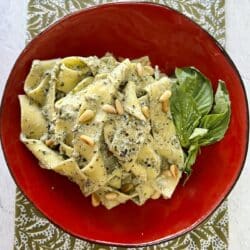
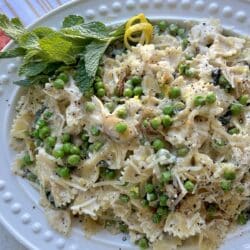
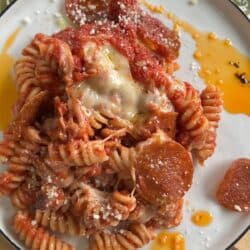
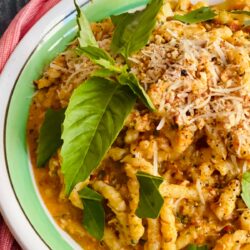
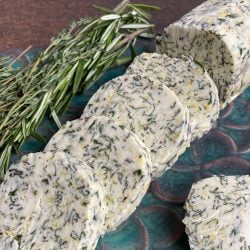
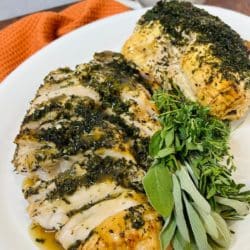

THIS WAS SO DELISH!!!! THE LEMON AND BUTTER MADE THIS ! THANK YOU MICHELE !
SO happy that you enjoyed the pesto recipe, Angela! Thanks for your comment.
This is my new go to pesto recipe . I love It and so does my family !!
I’m so happy that you and your family loved this pesto recipe, Sharon! Thanks for your comment.
I’m looking forward to making your pesto recipe for a summer pasta salad at my July 4th cookout!
Hope you enjoy the recipe, Claire! Thanks for the message.
Great recipe! Love the addition of butter in this pesto-it’s so creamy!
Thanks, Geralyn! Happy you like it.